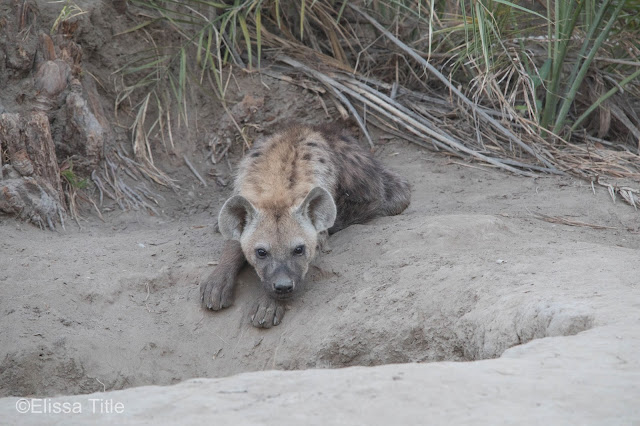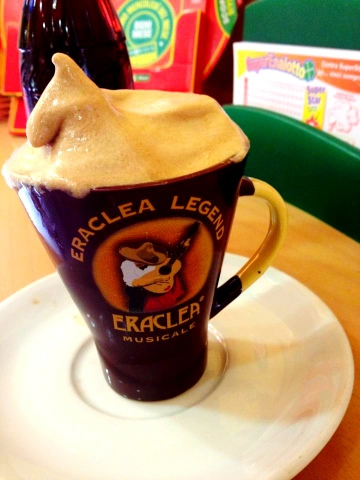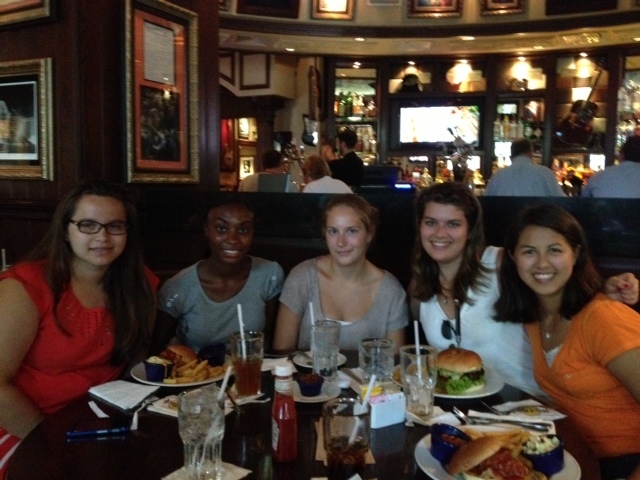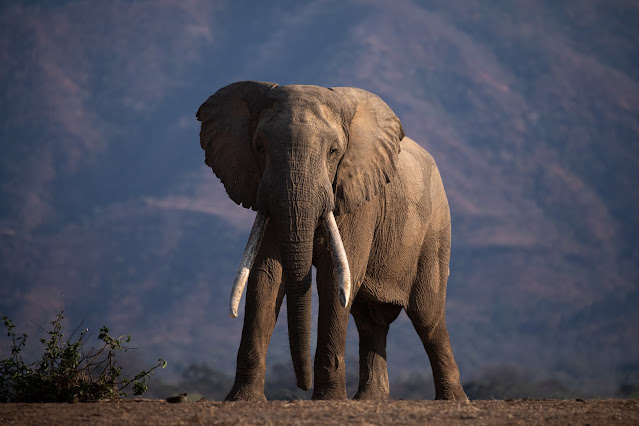On September 6, we had planned to go ashore at 9AM due to the tide. However, this is Alaska and weather changes quickly. Our photo leader met with the captain, and it was decided that we were going to travel to another bay for a change in scenery. With some nasty weather set to roll in, this would be our only opportunity to head to a different location to get some photographic variety. After breakfast, we pulled up anchor and set sail to Kuliak Bay.
 |
| Kuliak Bay in relation to Geographic Harbor. |
 |
| Panorama from the back of our boat. |
We photographed from the top deck as we approached a sea lion colony and apparently we also passed some puffins (though I didn’t see them, boo).
 |
| Panorama of "the sea lion rock", as we called it. |
 |
| A wave crashes against the rock as a sea lion prepares to dive into the water. |
 |
| While some people don't like to shoot into the sun, you get nice silhouettes. |
 |
| A bird takes off as our boat sails past. |
 |
| A mountain scene somewhere in Katmai. |
For lunch, we had a salmon burger with homemade tartar sauce. After lunch, we had more time to edit photos, complete with homemade snickerdoodle cookies, before having our second image review session. After an early dinner of halibut and beef tacos for our captain’s birthday, we went ashore in Kuliak Bay.
 |
| Beef and halibut tacos. |
We put on our waders once more... and off we went!
 |
| Wearing the lovely waders. |
 |
| The zodiac dropped us off on a rocky beach. |
We walked through waist high grass, where we briefly stopped to admire these cubs.
 |
| Two cubs peek out from the grass. |
Another group was upstream so we positioned ourselves downstream, but it was actually better because we could see bears in all directions. We waded through above knee-deep water to get to our shooting location: a small, sandy stretch of land that looked towards the waterfall.
 |
| Looking towards the waterfall, we could see a few bears fishing among the rocks. |
We ended up lying belly down on soft sand (a welcome change from the rocks at Geo) to get lower angles of the bears.
 |
| A sow with her two cubs. |
 |
| Cubs walk along the water's edge. |
A sow fished for quite some time... right in front of us. The first time a bear ran straight at us on day one, I was in shock. These giants could care less about you because of all the fish but you still find yourself holding your breath when you see a bear running at full speed in your direction, even after a few days of photographing them and learning their behavior patterns!
 |
| A bear charges at a salmon, full speed ahead. |
 |
| A bear comes running towards us. |
After watching mom fish for awhile, we observed the cubs walking up and down the edge of the water. Eventually, they sat down against a backdrop of vibrant berries.
 |
| One cub heads to a clearing among the berries. |
When I looked over my shoulder to the left, I saw more cubs approaching. I noticed a puddle and anticipated the moment the cubs would be reflected into the water.
 |
| Two young cubs walk upstream. |
At one point, we even squatted in the water with our cameras just barely above the surface of the water as bears were snorkeling and eating salmon right in front of us. Our wonderful photo guide took this behind-the-scenes pic of me. Anything for a photo, right? This is where the waders really came in handy. I didn't even get wet!
 |
| Behind the scenes photo of a wildlife photographer in her natural environment, courtesy of our wonderful photography leader. |
These are some of the photos I was able to get as a result:
 |
| A bear chews off the tail of the salmon. |
 |
| A blonde cub comes to the water, waiting for mom to catch a fish. |
 |
| A cub slowly walks along the water's edge as mom fishes. |
When it was time to leave, we had a sow and cubs coming straight towards us blocking our path so we had to wait, and then race to the shore so the zodiac wouldn’t get stuck with the tide.
 |
| Road block!! |
 |
| Cruising towards our boat as the tide was going out. |
After quickly starting our photo downloads, we gathered in the galley to sing happy birthday to our captain and celebrate with key lime pie.
The next morning, September 7, we went back ashore in Kuliak Bay. Since the tide was much lower than yesterday, we were dropped off in a different location and ended up having to hike in. When we’re ashore, we need to walk as close to one another as possible since we can have bears in any direction. It’s even more important to be close together in this particular location because you hike through waist-deep grass to get to the stream. Upon getting out of our zodiac, we walked across slippery rocks, up and over a hill of looser rocks, through knee-deep water...
 |
| An example of walking through the water! |
...Through the waist-deep grass (where we, at one point, saw a bear pop their head up… it’s really easy for bears to get lost in grass like this which makes it hard to spot them until they're right near you).
 |
| Walking through the grass to get to our photo location. |
Eventually we came around to the waterfall where the other group had been shooting the day before. We eventually settled down directly across from the waterfall.
 |
| A bear catches a fish by flipping over rocks. |
When we arrived, we saw quite a few bears “fishing”. I have quotes around fishing because compared to the bears we saw in Geographic Harbor that were running upstream and downstream chasing salmon, the bears in the waterfall were lazier. They turned over rocks with their paws to claw at the salmon passing by.
 |
| A bear uses a rock as a dinner plate to rip apart the salmon. |
 |
| A bear feasts on salmon. |
 |
| This bear rested the salmon on the top of its paw and would bend over to eat it. |
We also saw snorkeling bears right in front of us—the bear wades into the water, puts its head down, blows bubbles and ends up catching a fish that way. Below is a video I took on my camera. Click the play icon to view it. You might have to click it twice!
... And now for some photos...
 |
| A bear wades into the water. |
 |
| A bear puts its head down under the water, looking for salmon. |
 |
| Spotting a salmon, a bear lunges straight at us. |
 |
| Lying down, I got this photo from a low angle. |
 |
| A bear delicately rips apart salmon, despite its massive claws. |
At one point, I was holding my breath as a bear caught a salmon right in front of us—so close that you could take an iPhone picture because my telephoto was too much glass.
 |
| One of the guests on our trip photographs a bear who brought a salmon right to us. Two seconds earlier, I was sitting where his backpack is. |
The mosquitos were extremely annoying on this shoot—they were around our eyes, biting at our temples, and constantly trying to fly into my buff which I had pulled up to the bridge of my nose to try to ward them off (unsuccessfully). I learned that deet melts the plastic parts of camera gear, so no bug spray for me!
 |
| You can see all the bugs flying around me. No one ever said wildlife photography was glamorous! |
For all of you wondering just how close we were... This is a video I took on my iPhone of a bear fishing right behind me. You can see all the salmon in the crystal clear water. Click the play icon to view it. You might have to click it twice!
We loaded back onto to the zodiacs and pulled up anchor.
 |
| Landon brings over the zodiacs. |
After a fantastic morning shooting in Kuliak, we started making our way back to Geographic Harbor (where we now need to stay because of bad weather—we’d be too exposed to the elements going further up north and our captain would have a harder time returning to his home. We’re the last trip of the season). After brunch on board, we admired the landscape, passing the sea lion rock once more. Surprisingly, we came across a pod of orcas which aren’t usually seen in this area (though technically they can be seen anywhere).
 |
| An orca swims off our bow. |
Photographing on the deck in flip flops and no gloves (my lazy afternoon editing attire basically), the bitter cold wind was slapping at my face but I wasn’t about to move. Sometimes it’s the moment you least expect that is one of the most special on the trip. Orcas are especially difficult to photograph because they’re more submerged in the water compared with other aquatic wildlife I’ve photographed. I ended up taking a video just to remember the experience and in case my photos didn’t turn out well. When I got really cold, I headed inside and watched from the bridge.
 |
| Hanging out with Captain Rob in the bridge. |
In the afternoon, we took a zodiac ride around Hidden Harbor which is on the way back to Geographic Harbor. We stopped here even though it’s been hit or miss with bears and while we saw some salmon, we only saw one bear. Funny enough, the bear got scared off by a jumping salmon, so we named him “scaredy bear”. I only got this one photo before the bear ran back through the grass.
 |
| Our scaredy bear that got scared off by salmon. Are you even a bear??? |
We took the zodiacs and explored the entire bay, checking for bears everywhere, but we didn’t see any more. We did come across two bald eagles (an adult and a juvenile) and it was nice to just be out in the zodiacs regardless.
 |
| A bald eagle sits atop a small island. |
The bald eagle is named for the white head of the adult bird. It was named by American colonists at a time when bald meant white, not hairless. It takes about 5 years for the white plumage to gradually develop. As with many raptors, the females are larger than the males and these raptors can have a wingspan of up to 7.5 feet. They’re more abundant in Alaska than anywhere else in the United States (they’re found only in North America) though some leave the state during cold months.
In 1917, the Alaska Territorial Legislature imposed a bounty on eagles in response to claims by the salmon industry that eagles were competing with their livelihood. The bounty system lasted 36 years and led to the killing of a confirmed 120,195 eagles (and more for which no bounty was paid—those aren’t included in the count). The bounty was eventually removed, and bald eagles came under the federal Bald Eagle Protection Act which made it illegal to kill or possess an eagle, alive or dead, or to possess any part of an eagle including its feathers. Now, biologists estimate there are 100,000+ bald eagles in Alaska. Throughout most of the lower 48 states, they’re endangered due to habitat destruction, illegal shooting, pesticides, and poisoning. However, stronger protections for the species, improved habitat and water quality have helped their recovery and in 2007 they were removed from the list of threatened and endangered species. We didn’t see many during our trip, but our main focus of the trip was bears specifically. After our zodiac ride, we pulled up anchor and sailed to Geographic Harbor.
 |
| Our boat in Hidden Harbor prior to pulling anchor. |
I didn’t mind the fact that we were based in Geo for the rest of the trip because out of the places we had seen, this location had the highest bear density. With 30 knot winds approaching, we were also protected from the elements much better than other locations.
Thanks for reading about my adventures… Stay tuned for what's to come! As always, follow my instagram @elissatitle for more pics.






















































Loving this! Such an evocative description. Almost like being there. :)
ReplyDelete